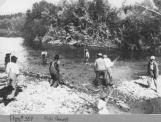15
Inter Tribal Trading SitesPrior to contact, the Tribal Nations would gather seasonally to trade goods with neighbouring peoples. At the various sites listed there were encampments where people gathered upwards of 2000 - 5000 people.
In these areas, the tribes would engage in games or competitions as a form of social gathering and to demonstrate their strengths as a people.
Some of these areas included but were not limited to:
Twin Lakes Flats
Princeton Flats
Driscoe Island - Oroville WA. Fishing Season and Trade Fair Time
Coyote's Dam, Salmon Fisheries - near Oroville WA.
Rock Creek
Montana - (Pipestone)
Brewster, WA
Tulameen
Skagit
Spences Bridge
Border Creek trading ground for candlestick oil. Eulican fish.
Skagit and Similkameen Guard Rocks
Hayes Creek where it meets Osprey Lake and Trout Creek is a major village area.
Lake de Femme - was origal encampment of Chief Black Eyes. This areas was one of the largest winter encampments, estimated at 2200 people.
16
Internal Community TradingThe elders have told oral stories that in the times of pre-settlement the neighbouring communities and nations of indigenous peoples were provided for after the needs of the local peoples. The neighbouring people and communities took what they needed for food and staple caches. The tribes knew where caches were kept and would bring their trade goods for the resources they needed. Similkameen people had their own recognized camp at each event whether it be social, tribal wars, hunting, food gathering, or fishing camps. For example there were annual trades, such as berries for salmon. Medicines were also gathered by communities for use by the people.
Some examples of trade goods were:
Export Import
Ochre Sweetgrass
Tobacco Salmon, fresh/dried
Hemp Euligan
Soapstone Dentallia Shells
Wild Teas Grizzly Bear Claws and Teeth
Berries Pipestone
Horses Trade beads (Hudson's Bay)
Abalone
This inter-dependent relationship resumed upon an influx of settlers to the Similkameen Valley and formed the basis for the spirit of cooperative living that continues between the communties of Native and Non Native peoples today.
As Similkameen people were settled onto reserves esablished by the federal government, locally the people would stop to camp over with the Marcel Family on their way back from Penticton. Most families traveled on horse and buggy.
17
IntegrationThe migration of non native peoples in the valley came as a result of establishment of Hudson's Bay posts in the area. The area was also explored by missionaries that were sent to live amongst the people.
The original people came from the east and from the south. It was noted by Hudson's Bay personnel that Similkameen people could not be readily converted into trappers for the company, due to their wealth and independence as a people.
Some of the animals that were hunted and trapped in the area at the time of the Hudson's Bay Trading era were:
Hunting Trapping
Elk Lynx
Lynx Squirrel
Moose Otter
Groundhog Bobcat
Sheep Beaver
Bear Weasel
Deer Muskrat
Rabbit
Fox
18
Mrs. Nehumpchin and Mrs. Edward - Meat drying in background1930's
Nehumpchin Village, Chopaka BC, Canada
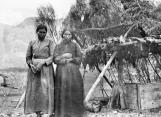 Credits:
Credits:Ann Briley Collection, Okanagan County Historical Museum
19
Annie (Newhimmekin) Holmes drying fish1940
Mission grounds, near Hedley BC, Canada
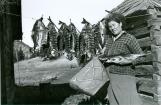 Credits:
Credits:Carrie Allison
20
Carrie Allison picking huckleberries at Dornsburg, on Tulameen river1960
Dornsburg, near Tulameen BC
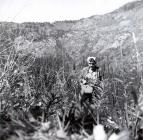 Credits:
Credits:Carrie Allison
21
Betty Terbasket and others root digging at White Lake( west of Ok Falls BC) near the Obervatory.1940
White Lake, near OK Falls BC
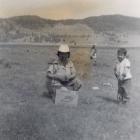 Credits:
Credits:Betty Terbasket
22
FishingKickinee at Trout Creek and Misseula Lake
Spuklic (Burdock) at Palmer Lake and Lorne Lake
Salmon fishing at McIntyre Bluff and at Coyotes Dam near Oroville Washington
Trout fishing at local creeks and rivers
Fish Trades occurred with the Stolo, the Nlakampemx and Nicola people.
Euligan (Candle Fish) with the Coastal villages.
Hayes Creek was a major village area
Tulameen was a major encampment by Chief Black Eyes of the Similkameen. The encampment was settled by 2200 people.
24
Settlement of the AreaFollowing the settlement by Hudson's Bay Company the valley was invaded by settlers moving in for the Gold Rush. As settlers were coming forth the area was in danger of being taken over by the United States. The Similkameen People made agreement with the representative of the Queen of England that they would co-exist with newcomers to the area. Upon initial agreement it was decided that no one other than the Queen could change the initial agreement made with the Indigenous peoples of the land. This was a decision made and understood by all native peoples of the area throughout the Thompson, Okanagan and Similkameen areas.
The agreement was that "As long as the major rivers flowed and the sun rose on the lands, the people of Similkameen would be respected. They would maintain use and occupation of the lands and would contiue to use the lands resources for sustainability of its peoples without interruption forever. " This agreement formed the basis for what later became the BC Flag to document the same said agreement.
25
Foods of the Similkameen PeopleThe Similkameen were hospitable people that helped the orignal settlers by providing and teaching them about foods, medicines and shelter. They also taught them about the area and the trails. Many of the foods and materials were used by our people and continue to be used today.This is a general list of foods and materials used.
Food Cultural Materials
Bitter root Hemp Rawhide
Camas Cedar root Bone
Wild Potatoe Birch Teeth of animals
Wild Celery Sinew Turtle Shell
Wild Onion Flint Hoofs
Yellow bells Soapstone Eagle feathers
Mushrooms Ochre Hawk feathers
Saskatoons Yew Flicker feathers
Chokecherry Iron Wood Animal pelts
Huckleberry Buckskin
Wild raspberry Rawhide
Wild strawberry Corn crushers
Blackcaps Cottonwood
Oregon Berry Willow
Elderberry Pipestone (traded)
Blueberry Sweetgrass (traded)
Wild rose Obsidian
Wild tea Pemican
Sunflower Abalone (traded)
Dried meat Dentallia
Smoked and Cured meat Reeds
Service Berry
26
Lorenzetto Family , Bottom Toby, Andy, Kate, Morris. Above Hazel1940
Hedley BC, Canada
 Credits:
Credits:Margaret Kruger
27
Farming and RanchingWild horses were moved from Palmer Lake through the valley to Princeton. Horses were taken to Oliver for grazing. The Similkameen people providedorses for World War I and World War II. At the peak of the horse runs there were approximately 1500 head in the Similkameen Valley. At this time, Similkameen people were consumers of horse meat.
The Similkameen people were well known fo rtheir outstanding quality of horses and horsemanship. In the past, Similkameen people were the supplier of horses to the Russian army. The 1960's saw the destruction of the Horse herds as there came to be a bounty out for the horses. As the valley was settled, there came to be a perceived over abudance of horses.
As communities were further agriculturally developed, they incorporated cattle ranching as a way of life. There were many successful ranches that existed within the community. Some of these included:
Early Farmers and Ranchers Yakumticum, Showdy Ranch, Narcisse, Billy Francois, Shorty Michelle, Jimmy Robinson. Indian Edward, Qualtier Ranch, Allison Brothers, Showdy Creek Ranch, Harry Robinson, Abraham Louie, Hans Richter, Willie Terbasket, Eneas Nehumpchin, Paul Terbasket, Alex Skius, Joe Dennis, Johnny Chuchuwasket, Harry and George McGinnis, Pierre John Ranch, Johnnie Holmes, Charlie Allison, Wici Allison, Harry Squakin, Pinto Jack.
Current ranches include. Qualtier Ranch, Allison Ranch, Louie Ranch, Gottfriedson Ranch, Blind Creek Ranch, Henry Dennis Ranch, Robert Dennis Ranch, Turtle Creek Ranch, Ralph Bent Ranch,

